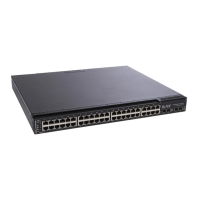© Copyright IBM Corp. 2011 Chapter 14. VMready 167
The following rules apply to the local VM group configuration commands:
•
key
: Add LACP trunks to the group.
•
port
: Add switch server ports or switch uplink ports to the group.
•
portchannel
: Add static port trunks to the group.
•
profile
: The profile options are not applicable to local VM groups. Only
distributed VM groups may use VM profiles (see “VM Profiles” on page 168).
•
stg
: The group may be assigned to a Spanning-Tree group for broadcast loop
control (see “Spanning Tree Protocols” on page 115).
•
tag
: Enable VLAN tagging for the VM group. If the VM group contains ports
which also exist in other VM groups, enable tagging in both VM groups.
•
vlan
: Each VM group must have a unique VLAN number. This is required for
local VM groups. If one is not explicitly configured, the switch will automatically
assign the next unconfigured VLAN when a VE or port is added to the VM group.
•
vmap
: Each VM group may optionally be assigned a VLAN-based ACL (see
“VLAN Maps” on page 173).
•
vm
: Add VMs.
VMs and other VEs are primarily specified by MAC address. They can also be
specified by UUID or by the index number as shown in various VMready
information output (see “VMready Information Displays” on page 175).
If VMware Tools software is installed in the guest operating system (see VMware
documentation for information on installing recommended tools), VEs may also
be specified by IPv4 address or VE name. However, if there is more than one
possible VE for the input, the switch will display a list of candidates and prompt
for a specific MAC address.
Only VEs currently connected to the switch port (local) or pending connection
(pre-provisioned) are permitted in local VM groups.
Use the
no
variant of the commands to remove or disable VM group configuration
settings:
RS G8000(config)# no virt vmgroup <VM group number> [?]

